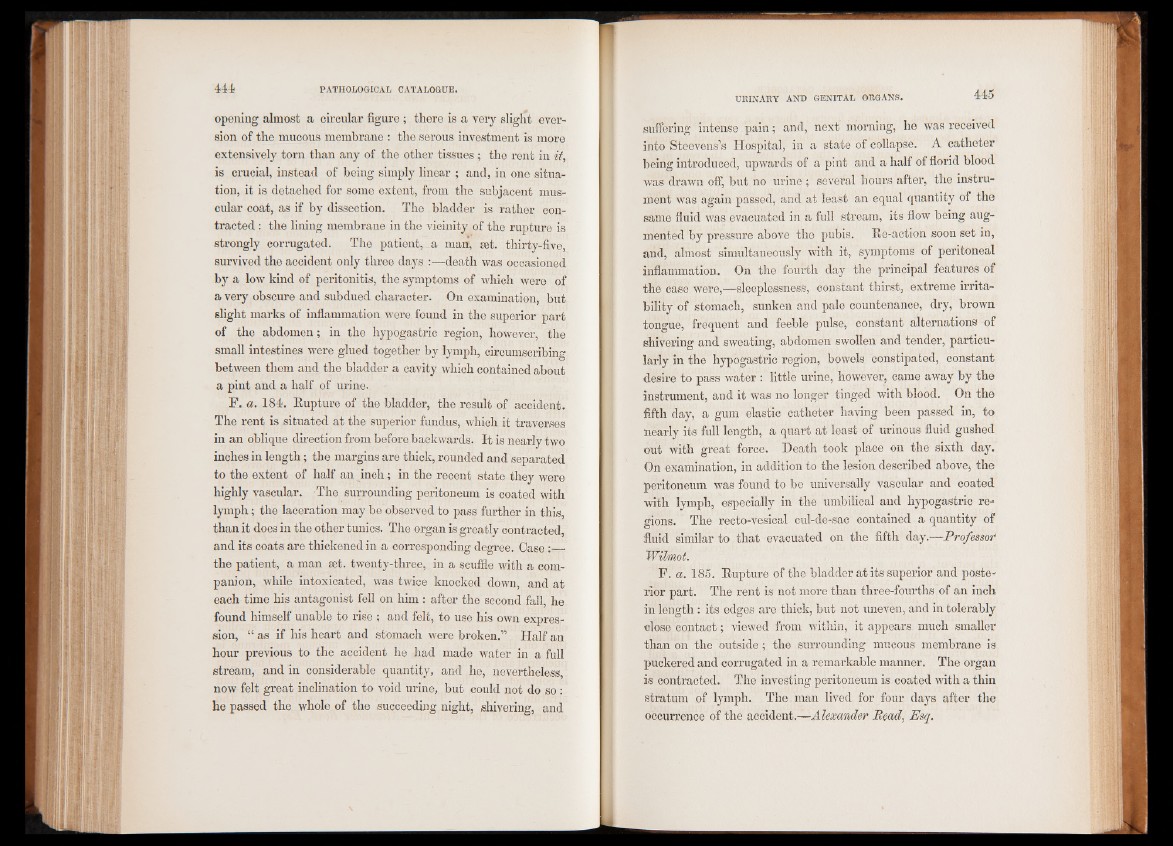
opening almost a circular figure ; there is a very slight eversion
of the mucous membrane : the serous investment is more
extensively torn than any of the other tissues ; the rent in it,
is crucial, instead of being simply linear ; and, in one situation,
it is detached for some extent, from the subjacent muscular
coat, as if by dissection. The bladder is rather contracted
: the lining membrane in the vicinity of the rupture is
strongly corrugated. The patient, a man', set. thirty-five,
survived the accident only three days :—death was occasioned
by a low kind of peritonitis, the symptoms of which were of
a very obscure and subdued character. On examination, but
slight marks of inflammation were found in the superior part
of the abdomen; in the hypogastric region, however, the
small intestines were glued together by lymph, circumscribing
between them and the bladder a cavity which contained about
a pint and a half of urine.
F. a. 184. Rupture of the bladder, the result of accident.
The rent is situated at the superior fundus, which it traverses
in an oblique direction from before backwards. It is nearly two
inches in length; the margins are thick, rounded and separated
to the extent of half an inch; in the recent state they were
highly vascular. The surrounding peritoneum is coated with
lymph; the laceration may be observed to pass further in this
than it does in the other tunics. The organ is greatly contracted,
and its coats are thickened in a corresponding degree. Case :_
the patient, a man set. twenty-three, in a scuffle with a companion,
while intoxicated, was twice knocked down, and at
each time his antagonist fell on him : after the second fall, he
found himself unable to rise ; and felt, to use his own expression,
“ as if his heart and stomach were broken.” Half an
hour previous to the accident he had made water in a full
stream, and in considerable quantity, and he, nevertheless,
now felt great inclination to void urine, but could not do so:
he passed the whole of the succeeding night, shivering, and
suffering intense pain; and, next morning, he was received
into Steevens’s Hospital, in a state of collapse. A catheter
being introduced, upwards of a pint and a half of florid blood
was drawn off, but no urine ; several hours after, the instrument
was again passed, and at least an equal quantity of the
same fluid was evacuated in a full stream, its flow being augmented
by pressure above the pubis. Re-action soon set in,
and, almost simultaneously with it, symptoms of peritoneal
inflammation. On the foui’th day the principal features of
the case were,—sleeplessness, constant thirst, extreme irritability
of stomach, sunken and pale countenance, dry, brown
tongue, frequent and feeble pulse, constant alternations of
shivering and sweating, abdomen swollen and tender, particularly
in the hypogastric region, bowels constipated, constant
desire to pass water : little urine, however, came away by the
instrument, and it was no longer tinged with blood. On the
fifth day, a gum elastic catheter having been passed in, to
nearly its full length, a quart at least of urinous fluid gushed
out with great force. Death took place on the sixth day.
On examination, in addition to the lesion described above, the
peritoneum was found to be universally vascular and coated
with lymph, especially in the umbilical and hypogastric regions.
The recto-vesical cul-de-sac contained a quantity of
fluid similar to that evacuated on the fifth day.—Professor
Wilmot.
F. a. 185. Rupture of the bladder at its superior and posterior
part. The rent is not more than three-fourths of an inch
in length : its edges are thick, but not uneven, and in tolerably
close contact; viewed from within, it appears much smaller
than on the outside; the surrounding mucous membrane is
puckered and corrugated in a remarkable manner. The organ
is contracted. The investing peritoneum is coated with a thin
stratum of lymph. The man lived for four days after the
occurrence of the accident.—Alexander Read, Esq.